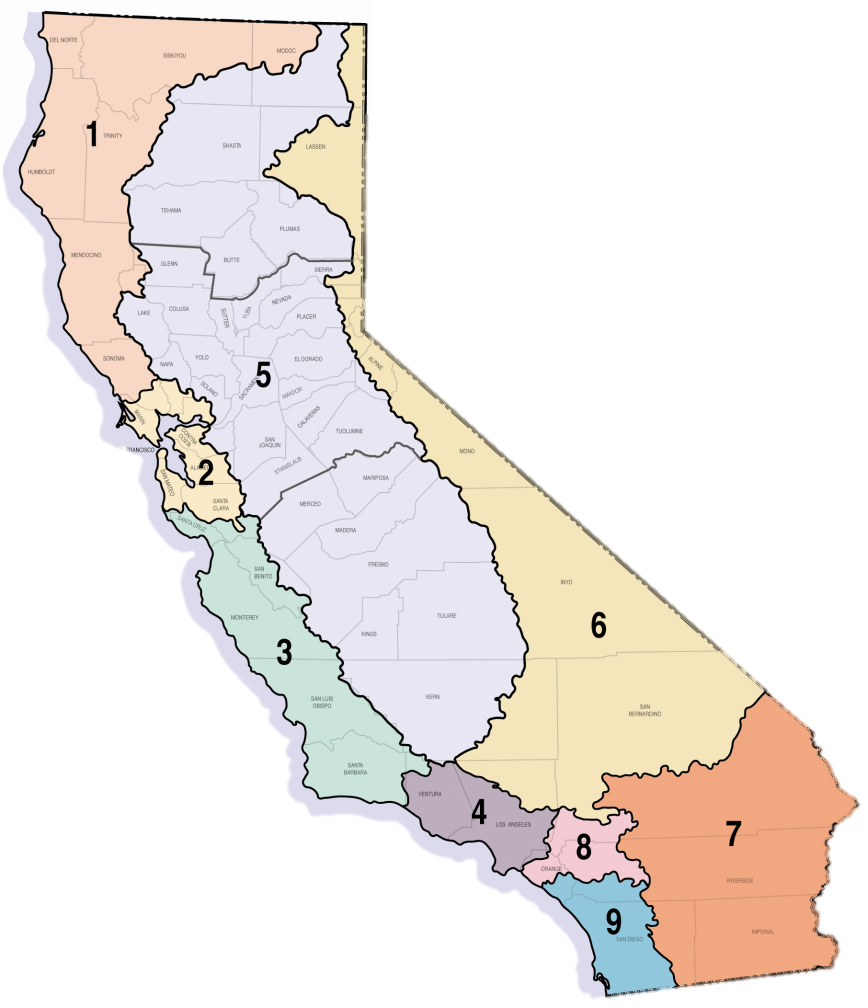How do the Water Boards protect groundwater?
The State Water Resources Control Board (State Water Board) and nine Regional Water Quality Control Boards (Regional Water Boards; collectively the Water Boards) are authorized to implement the federal Clean Water Act in California. The State Water Board protects water quality by setting statewide policy, coordinating and supporting the Regional Water Boards, and reviewing petitions that contest Regional Water Board actions. Additionally, the State Water Board is solely responsible for allocating surface water rights, regulating public drinking water systems, and administering financial assistance programs. The State Water Board protects groundwater through a number of programs (distributed through a number of divisions):
State Water Resources Control Board
DDW regulates public drinking water systems. Programs include:
- Drinking Water Source Assessment and Protection Program
- Drinking Water Treatment and Distribution System Operator Certification Program
- Environmental Labratory Accreditation Program (ELAP)
- Recycled Water
DFA administers the State Water Board's financial assistance programs. Programs include:
- Proposition 1 Funding
- Drinking Water State Revolving Fund (DWSRF)
- Water Recycling Funding Program (WRFP)
- Seawater Intrusion Control (SWIC) Loan Program
DWQ regulates and monitors water quality. Programs include:
- Brownfields Program
- Composting Operations
- Department of Defense (DOD) program
- Groundwater Ambient Monitoring and Assessment Program (GAMA)
- Irrigated Lands Regulatory Program (ILRP)
- Land Disposal Program
- Oil and Gas Monitoring Unit
- Site Cleanup Program (SCP)
- Underground Storage Tanks (UST)
- Waste Discharge Requirements (WDR) Program
OSGM implements the Sustainable Groundwater Management Act (SGMA), a California law that was designed to ensure groundwater resources are managed sustainably for the long-term benefit of communities, farms, businesses, and the environment. SGMA emphasizes local groundwater management, but, if local management is insufficient, SGMA allows the state to take a range of actions through a process called state intervention.
Water Rights allocates surface water permits subterranean streams. Programs include:
- Public Trust
- Subterranean Streams
For more information on these programs, visit the program’s website (accessible through the Programs tab).
The Regional Water Boards are semi-autonomous. Each regional board makes critical water quality decisions for its region, including setting standards, issuing permits, determining compliance with those requirements, and taking appropriate enforcement actions. For more information about Regional Water Board activities, visit the Regional Water Board websites:
- North Coast Regional Water Board (Region 1)
- San Francisco Bay Regional Water Board (Region 2)
- Central Coast Regional Water Board (Region 3)
- Los Angeles Regional Water Board (Region 4)
- Central Valley Regional Water Board (Region 5)
- Lahontan Regional Water Board (Region 6)
- Colorado River Basin Regional Water Board (Region 7)
- Santa Ana Regional Water Board (Region 8)
- San Diego Regional Water Board (Region 9)
The Water Boards protect groundwater through regulatory and planning programs. The key elements of this approach include:
- Identify and update beneficial uses and water quality objectives
- Regulate activities that can impact the beneficial uses of groundwater
- Prevent future groundwater impacts through planning, management, education, monitoring, and funding

Identify and update beneficial uses and water quality objectives
The Water Boards adopt and implement numerical and narrative standards called water quality objectives (WQOs) to protect beneficial uses of groundwater. For example, if groundwater quality is considered adequate for drinking water, then the protection standard (WQO) for any pollutant in the groundwater would be equivalent to, or lower than, the State's drinking water standard, or maximum contaminant level (MCL) for protection of human health. If, for example, the groundwater is considered adequate for crop irrigation, industrial processes, or stream replenishment, then the protection standard would be based on pollution limits protective of those uses.
In order to implement appropriate protection standards for groundwater, the Water Boards identify the actual and likely future groundwater uses, and the applicable protection standards for each groundwater basin. Groundwater beneficial uses and WQOs are included in their respective Regional Board Water Quality Control Plan (Basin Plan). Basin Plans can be found here. Additional information on a region’s Basin Plan(s), and the update process, is available on the respective Regional Water Board website.
Regulate activities that can impact the beneficial uses of groundwater
The Water Boards implement several programs that regulate the discharge of pollutants to the ground, and cleanup pollution within the ground. These programs aim to prevent the release of hazardous substances from a variety of facilities – such as landfills, waste disposal sites, service stations, refineries, and other industrial facilities. These programs also aim to clean up spills and leaks that may occur.
Prevent future groundwater impacts through planning, management, education, monitoring, and funding
In addition to its regulatory programs, the Water Boards play an important role in facilitating and promoting development of groundwater management strategies and implementation of groundwater protection concepts at the local level.
Focused ambient groundwater monitoring is an important part of preventing future impacts because it provides a baseline evaluation of regional groundwater quality. The Groundwater Ambient Monitoring and Assessment (GAMA) program involves sampling community and domestic water supply wells for a variety of historic and emerging pollutants using ultra-low detection limits. The Water Boards use these data to help prioritize cleanup work and permitting decisions to ensure that high quality groundwater is protected.
The State Water Board provides grants and loans for constructing municipal sewage and water recycling facilities, remediation for underground storage tank release, watershed protection projects, nonpoint source pollution (NPS) control projects, public drinking water system projects, and other projects. The State Water Board has several financial programs to help local agencies and individuals prevent or cleanup pollution of the state’s surface water and groundwater.


